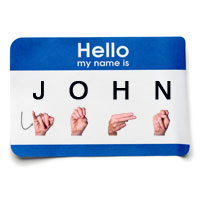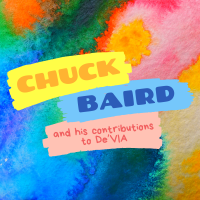Learning Tips Articles
Directional Verbs
There are a group of verbs that are often referred to as Directional Verbs. These are also known as Indexical verbs or Verb Agreement. These verbs do just what the term suggests; they show directionality. They do this by using an element of motion that indicates one or more referents (see post on Setting Up People, Places, and Things for more on referents). These verbs can be used pretty simply by setting people up, then using ...
Setting Up People, Places and Things
The use of space is a very important feature in American Sign Language. The way to be able to refer back to different people, places or things (referents) is to use the space around the signer. You do this by setting up the space. This is done in a three dimensional manner. It can be done in the space to the left or right of the signer, in front of the signer, in a semi-circle around ...
Making signs plural or in the past tense
We have received several emails asking how to make signed words plural or showing if something happened in the past, as well as having emphasis to show desire.
There are a few different ways to do this:
One way to show an emphasis or plurals is to repeat the sign. For example, if you are wanting to say “He wants that really bad!” You would sign WANT+WANT+THAT+HE. That double use of the sign want shows that he really wants ...
How do I get my signs to flow together so that I don't look choppy when I am signing?
As a beginning signer, it is just natural that you will be choppy. Once you get a larger sign vocabulary, you will not be so worried about searching for a way to say something that you know the signs for and you will be able to focus on the flow of your signs.
When you sign music it also helps with the flow if you let the music guide you. There are a few different sites on the internet ...
How long until I am a fluent signer?
Many people often ask me this question. That is really a hard one to answer because everyone's rate of learning a new language varies greatly. The motivation behind the learning is going to be a key factor as well as the opportunity to actually practice what you are learning with multiple signers.
It is important to practice signing with, and reading from, many signers as you learn so you don't just get used to the way one particular person ...
Tips for Reading Fingerspelling
Many people talk to me about their frustrations with fingerspelling and want suggestions on how to improve their receptive skills when it comes to reading fingerspelling.
My suggestions tend to follow a lot of the same rules that apply to teaching a child to read:
Practice, practice, pratice...the more you work on reading other people's fingerspelling, the better you will get. Everyone's fingers are different so it is important to practice with many different partners in order to experience all the ...
Using Figurative Language with Sign
Many people have asked how to sign things that say one thing but mean something else. This happens a lot in the English Language!
Some Examples: It's raining cats and dogs!, or You look really sharp today.
Now as native users of the English language, we know that neither cats or dogs are falling from the skies .nor is the person in the second sentence looking rather pointed. These are concepts that people who are learning English as a ...
Conceptually Correct Signs
Consider the following sentences:
I won’t stand for this!
You need to stand up please.
This flag stands for freedom.
In each of these statements the word STAND is used. It is spelled the exact same way, pronounced the exact same way, yet it has VERY different meanings in each of it’s uses above.
Now one form of sign language, Signing Exact English, would tell you to sign the word STAND the same in all three sentences because of their 2 out of 3 ...
Does it matter what hand you use?
When signing, it does not matter if you sign as left-hand or right-hand dominant. The biggest thing to remember is to pick which hand you want to use as the dominant hand and stick with it. You should not switch back and forth between dominant hands. Most signers will be able to understand your signs no matter which hand you use as the dominant hand.
I am actually left-handed but choose to use my right hand as the more dominant hand ...
Signing People's Names in American Sign Language
Signs for common names?
My name is John, which, as you may guess, is a pretty common name. The benefit of having a common name growing up is that whenever I went into a gift shop that had items with names on them, such as cups, buttons, belts, or what-have-you, I could always find one with my name on it. In sign langage, unlike the items in the gift shop, there is no sign for John. That is, there is no ...








